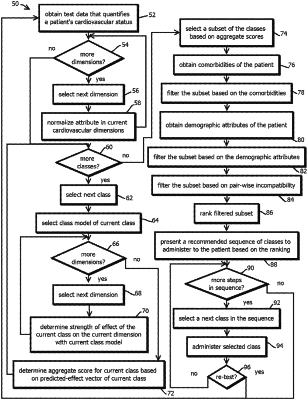| CPC G16H 50/20 (2018.01) [G06N 5/04 (2013.01); G16H 20/10 (2018.01); G16H 50/30 (2018.01); G06N 20/00 (2019.01)] | 38 Claims |

|
1. A tangible, non-transitory, machine-readable medium storing instructions that when executed by one or more processors effectuate operations comprising:
obtaining, with an artificial intelligence (AI) application executed by a computer system, information about a current patient condition, wherein:
the information relates to a patient who has undergone heart failure,
at least some of the information is obtained from an electronic medical records system via an application program interface of the electronic medical records system,
at least some of the information is validated or entered into the AI application by a medical professional after obtaining information from the electronic medical records system, and
the AI application comprises:
a plurality of pharmaceutical-specific models each corresponding to a different class of pharmaceuticals to treat heart failure, and
an expert system comprising a plurality of rules in a rule-graph, the rule-graph being traversable to determine an updated prescription based on the patient condition and predicted patient responses from the pharmaceutical-specific models;
inputting, with the computer system, at least some of the obtained information about the patient condition into the respective pharmaceutical-specific models and, in response:
predicting respective changes in the condition of the patient responsive to respective changes in respective dosages of the respective classes of pharmaceuticals to obtain a set of predicted patient responses for the different classes of pharmaceutical,
selecting based on the set of predicted patient responses, candidate classes of pharmaceuticals for an updated prescription,
determining differences between target dosages and the current dosages of the classes of pharmaceuticals, and
based on the differences, determining respective priority scores of the respective classes of pharmaceuticals;
inputting, with the computer system, into the expert system of the AI application, the candidate classes of pharmaceuticals and their respective priority scores and, in response, determining an updated prescription; and
storing, with the computer system, the updated prescription in memory.
|